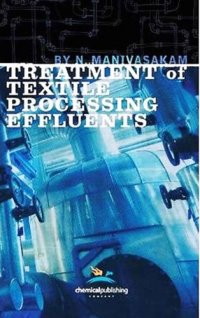Annotation
CONTENTS Chapter - 1. Introduction; Chapter - 2. Characteristics of Cotton Textile Processing Effluents; Sizing; Desizing; Scouring; Bleaching; Mercerizing; Dyeing; Printing; Finishing; Combined Effluent; Chapter - 3. Treatment of Cotton Textile Processing Effluents Chapter - 4. Charactristics and Treatment of Synthetic Textile Processing Effluents; Process and Characteristics of Effluents; Treatment; Chapter - 5. Knit Fabric Finishing; Chapter - 6. Characteristics and Treatment of Woollen Textile Processing Effluents; Chapter - 7. Recent Trends in Textile Waste Water Management; Chapter - 8. Reduction of Pollution Load; Waste segregation; Recovery Substitution of Low-Pollution Load Chemicals; Judicious use of chemicals; Process changes; Economy in Water use; Chapter - 9. Recovery and Reuse of Sizes, Dyes and Other Chemicals; Recovery of PVA and other Sizing agents; Caustic soda Recovery; Recovery of Dyes; Reuse of Ozonated Dyebath; Recovery of Other Valuable materials; Recovery of Heat; Chapter - 10. Recycling and Reuse of Waste Water; Chapter - 11. Conservation and Reuse of Water; Part - II. TREATMENT METHODS; Chapter - 12 Treatment Methods - An Introduction; Chapter - 13. Preliminary and Primary Treatments; Screening; Equalization; Neutralization; Neutralization of Acidic Wastes; Neutralization of Alkaline Wastes; Coagulation; Coagulants; Auxiliary chemicals; Flocculation - Aids; Coagulation Merits Sedimentation; Floatation (Dissolved Air Floatation); Chapter - 14. Secondary Biological Treatment; Activated Sludge Process; Trickling Filtration; Aerated Lagoons; Oxidation Ponds; Anaerobic Digestion; Sludge Disposal; Removal of Interfering Substances; Chapter - 15. Tertiary Treatment; Multimedia Filtration; Chemical Coagulation; Chemical Precipitation; Disinfection; Ozonation; Activated Carbon Adsorption; Membrane Technology; Dialysis / Electro Dialysis; Evaporation; Chapter - 16. Advanced Methods for the Treatment of Textile Processing Waste Water; Advanced Oxidation Processes; Ozone Treatment; Adsorption; Membrane Technology; Dialysis / Electrodialysis; Ion Exchange; Evaporation; Crystallization; Freezing; Some Patented Technics for Color Removal; Bio-mass based Technologies; Cutting-EdgeTreatment Methods; Chapter - 17. Advanced Oxidation Processes; Non-Photo chemical Methods; Ozonation; Ozone/Hydrogen Peroxide Process; Fenton Method; Homogeneous Photochemical Oxidation Processes; Vacuum-UV Photo Oxidation; UV and Ozone; UV and Hydrogen Peroxide; UV, Ozone and Hydrogen Peroxide; Photo Fenton Method; Heterogeneous Photochemical Oxidation Processes; Chapter - 18. Ozone Treatment; Reactions of Ozone in Waste Water Treatment; Oxidative Reactions and Color Removal; BOD Reduction; Sludge Reduction; Advancements in Ozone Treatment; Chapter - 19. Activated Carbon Adsorption; Chapter - 20. Membrane Technology; Micro Filtration; Ultra Filtration; Nano Filtration; Reverse Osmosis; Disc and Tube Module; Membrane Bio-Reactors; Part - III. ANALYSIS OF TEXTILE PROCESSING EFFLUENTS; Chapter - 21 Purpose of Examination; Chapter - 22. Collection of Waste Water samples; Chapter - 23. Recording of Results; Chapter - 24. Analytical Methods - Important Notes; Chapter - 25. Parameters to be determined on Textile Processing Effluents; Chapter - 26. General Physico-Chemical Measurements; Chapter - 27. Measurement of Organic Pollution; Chapter - 28. Inorganic Constituents - Non Metallics; Chapter - 29. Inorganic Constituents - Metals; Chapter - 30. Miscellaneous Determination; Appendix; Index.
�Read more...
Abstract: This book is written with the intention of providing textile processors with a clear picture of the effluents emerging from their industry, and to have a suitable treatment system that works efficiently and economically. �Read more...
Download the book Treatment of textile processing effluents for free or read online
Continue reading on any device:


